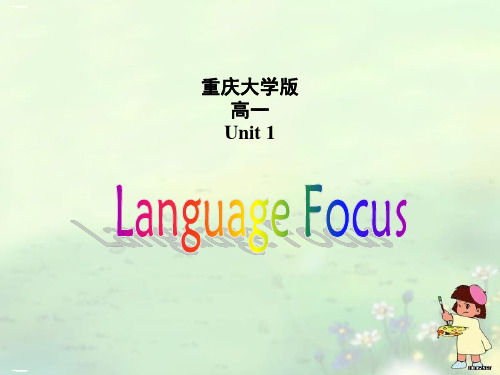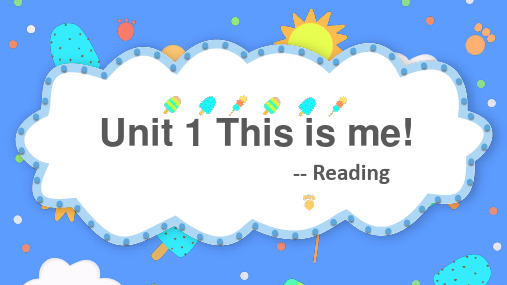reading in unit 1 in book 7解读
- 格式:ppt
- 大小:1.02 MB
- 文档页数:13

课题Unit1 Reading for writing 课时第7课时课型新授主备人审核人Learning objectives:By the end of the class students will be able to:1.基于写作目的,文体和要求,分析范文结构,列出描述自己和朋友的内容要点,形成结构化知识框架;(学习理解)2.基于知识框架,用第三人称的语言介绍玲玲和她的朋友;(应用实践)3.画出自己和朋友的思维框架图,描写自己和自己的朋友,完成征文。
(迁移创新)五步教学法:课前小测--自主学习--反馈解疑--课堂小结--当堂训练Learning procedures:[Test Before Class]Write down the new words as quickly as you e on!Believe yourselves!1.我来自北京。
2. 我喜欢打篮球。
3. 遇到彼此,我们很开心4.介绍Lead- in :Leading inWatch a video and know about the coming writing competition aboutyou and your friends.[Self-Study and Group Work]Activity 11.Look at the picture and predict what you are going to read about.2.Read and answer the following questions:(1)What’s the title of the text?(2)Why is the title named “ my friend and I ”not “I and myfriend ”?(3)How does Lingling introduce herself ?3.Read again and Complete the thinking map.4.Read and think:How does Lingling introduce herself ?How does Lingling describe Sally?Activity 2Draw a thinking map about yourself and your friend..(1).Your personal information and hobby(2).Your friend’s personal information and hobbyFRActivity 3 Draft your essay about yourself and your friend. Activity 4 Make your final draft in your exercise book.Activity 5 Invite your partner to rate your final draft.Write 1(more improvements needed),2(fair),3(good),or4(excellent)in the form below.[Explanation ]1.The structure of the passage :2.How to start and end a passage better?3.More useful expressionsFurther thinking:How many steps should we do if we want to write a wonderful passage ? What are they?[Summary]What have you learned today? Ask some students to make a summary.Self-assessment[Test in Class]Finish the composition about you and your friend.HomeworkMust do: 继续完善润色课堂的我和我的朋友作文。

Unit1 课文重难点同步解读1. look up〔课本第2页activity2〕look up为“动词+副词〞型短语,意为“查阅,查找〞,后面可跟名词或代词作宾语,如果look up的宾语是名词,该名词宾语可以位于look和up之间,也可以位于look up之后。
但如果look up的宾语是代词,该代词只能位于look和up 之间。
例:I often look up the new words in the dictionary.我经常在词典里查找新单词。
You should look it up again. 你应该再查一遍。
【拓展】常见的look短语有:look over 仔细检查look around 环顾四周look down 向下看look up 查阅;向上看look at 看look for 寻找look after 照顾look through 浏览2. We should always speak English in class. 在课堂上我们应该总是说英语。
〔课本第2页activity3〕(1) 在给别人提出建议或就某事表述自己的看法时,可以使用“should+动词原形〞这种形式。
should是一个情态动词,意为“应该〞。
should没有人称和数的变化,其否认形式为shouldn't。
例:You should listen to the teacher carefully in class.你应该课上认真听教师讲。
You shouldn't read a storybook in a maths class.你不应该在数学课上看故事书。
(2) in class意为“在课上〞;“在课后〞为after class。
class前不加冠词。
例如:Tom often plays football after class with his classmates.汤姆经常在课后与同学一起踢足球。




选修7unit1 Living Well单元教案马晓露一教材分析本单元以残疾及残疾人生活为中心,介绍了一些残疾人凭借顽强的毅力和社会的关爱克服生活中的种种困难,以积极的态度面对人生的挑战。
通过本单元的学习,提高学生理解、尊重、关心、帮助残疾人意识,使残疾人与健全人一样共享美好生活.这是对新课程目标中情感态度与价值观培养目标的全方位体现.二教学目标1。
知识目标a. 掌握以下重点词汇和短语ambition, disability, fellow, independent, beneficial, encouragement, in other words, all in all, out of breath, make fun of。
b。
理解和运用以下重点句型1. I have to adapt to my disability。
2. Just accept them for whom they are and give them encouragement to live as rich and full a life as you do。
2。
能力目标a。
通过对段落结构的分析,使学生掌握scanning的阅读技巧。
要提高他们的阅读速度和快速寻找信息的能力,培养他们的分析和概括能力。
b. 让学生理解残疾人及其生活情况,使学生明白身体有残疾并不意味着生活不如意,但他们在日常生活和工作中比健全人面临着更大的挑战.3.情感目标提高学生理解、尊重、关心和帮助残疾人意识。
加强合作意识、陶冶情操,培养正确的审美观和价值观。
三教学重点与难点1.教学重点:重点词汇句型的掌握2.教学难点:帮助学生理解残疾人所面临的种种困难,增强学生的同情心与爱心,引导他们珍惜时间,珍惜生活。
教学过程四教学方法任务型学习法多媒体辅助法合作性学习法Warming up,pre-reading and reading部分教学过程Step 1 Warming up1.Warming up by discussingFirst ask students to talk about people with a mental or physical disability to see how much they know about disabilities。